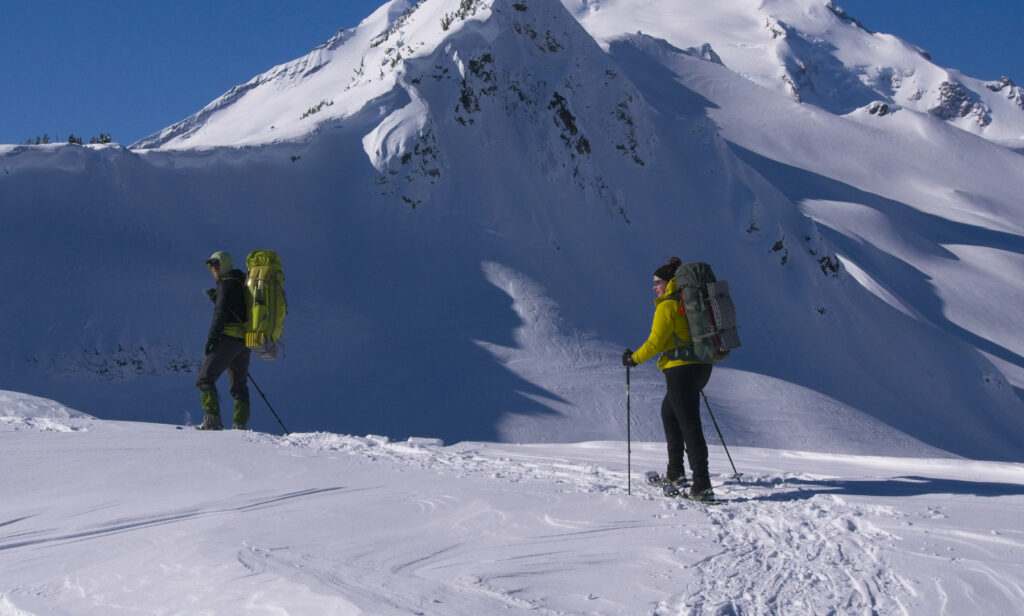Frequently Asked Questions about the Winter Backpacking Meetup, Weather, Safety, and Gear.
Questions are divided under topic headings, such as safety, liability, gear, and weather, but many answers overlap. The questions and answers provided are intended to help explain what you should know about the Meetup and what to expect if you join an outing.
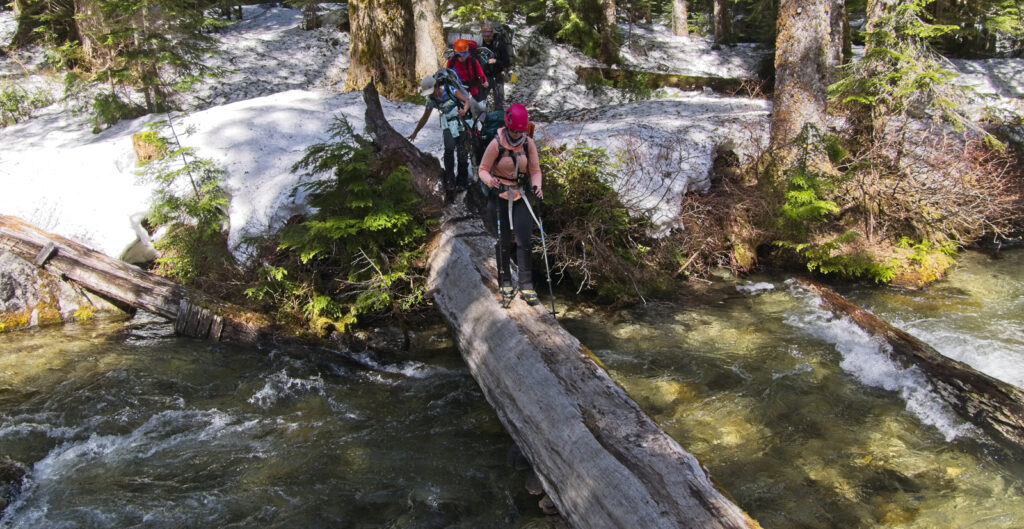
About the Meetup
- What is the purpose of the Winter Backpacking Meetup? Think of this meetup the same way you would think of a group of friends deciding to meet and hike together, except you may not know the people in the group. The Meetup is intended to bring hikers together who are interested in winter backpacking, making new friends, and pioneering a new kind of winter recreation. It is a mutual learning experience. This is only a free meetup. Unlike a mountain touring business, there is no revenue to hire trained mountain guides or medics.
- What do you like most about winter backpacking? Many things, such as the pristine quality and solitude of the wilderness landscape, the company of the other hikers, the challenge of snow travel, the quality of sleep at night. It is especially satisfying to be able to enjoy the beauty of the wilderness while being completely comfortable in harsh cold and windy conditions.
- What is better about backpacking in the winter? No mosquitoes or biting nats, no forest fires, no permit requirements, and no competition for campsites. The trails and campsites are covered by snow so you can hike almost anywhere and snow creates an abundant water supply at all locations.
- Where do your activities take place? Mostly in the Cascade Mountains of Washington State.
- Why is the Meetup called “winter” backpacking when year-round events are included? The main emphasis is winter skills and snow camping. Calling it “Winter Backpacking” helps people understand the core mission of the meetup. Even in summer, we are often hiking to high destinations to find snow. The ability to camp comfortably on snow increases the number of places we can camp and gives us the best views while leaving no trace on the wilderness. However, we have also done trips to the coast and on the Pacific Crest Trail in the summer.
- Is there any discussion in the group about diversity, equity, and inclusion? Our current membership is diverse, but many of us are interested in finding ways to reach out to less represented groups and lowering barriers for participation by actively encouraging participation, sharing knowledge, and making gear available to people who don’t have and can’t afford expensive winter gear. A key part of trip planning is making plans that fit people with different levels of ability and helping them progress into more difficult hikes and challenging conditions.
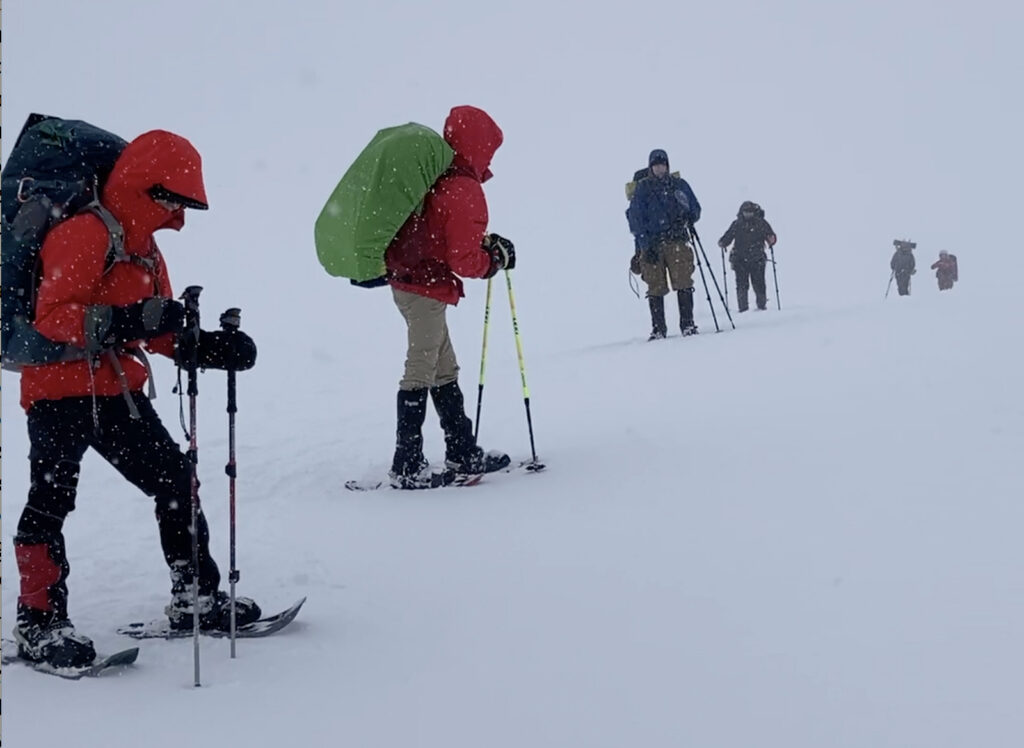
Safety, hazards, and individual responsibilities
- Who is responsible for my safety if I join? You are. Other hikers and the organizers can help each other stay safe, but you are responsible for your own safety. Everyone who signs up for an event must be fit, must have the correct gear and know how to use it, and must be able to solo camp if necessary.
- Are the organizers making sure the winter backpacking trips are safe? No hike is free from hazards. All outdoor recreation involves life-threatening risks, such as falling rocks, avalanches, and slippery ice. It is your responsibility to know what risks you are accepting. It is everyone’s individual responsibility to check the avalanche forecast, mountain weather forecast, and directions and decide what risks they are taking.
- What precautions do the organizers take? Safety is not guaranteed, but there are many things hikers can do to increase their safety in the backcountry, such as traveling in a group, carrying avalanche gear and wind protection, practicing transceiver recovery, learning how to evaluate snow conditions and avalanche dangers, avoiding high-risk slopes, hiking on the windward side, spreading out on slopes, watching and listening for avalanche signs, etc. Because some hikers are beginners, skills and abilities in the group will vary.
- Are members required to take avalanche and first-aid classes to attend? Like other hiking groups, prior training is encouraged but not required. However, for some trips, an avalanche transceiver, snow shovel, and probe are required so you can be located and assist in a rescue if needed.
- Isn’t carrying an avalanche transceiver, snow shovel, and probe without proper training pointless? No. Everyone can learn how to wear and turn on a transceiver at the trailhead. Even if you don’t know how to use a transceiver in a rescue, a transceiver can still help people find and rescue you. Locating a transceiver signal and avalanche shovel skills take time to learn, but even an unskilled person can assist in a rescue. We want to encourage everyone to acquire avalanche gear and start the learning process as soon as possible.
- What is the most dangerous aspect of winter backpacking? There are many dangers, but driving to the trailhead might statistically be the most dangerous part of the trip, both on the highways and the forest roads, and regardless of the time of year. Always pack tire chains. Other real dangers include falling through the snow, slipping on steep slopes, and avalanches. Everyone is encouraged to wear a climbing helmet at all times when there is ice on the trail or potential snow bridges and hidden wells.
- Can I rely on a cell phone instead of an expensive avalanche transceiver? Absolutely not. Currently, cell phones do not provide a reliable way of being located in the wilderness or locating someone else. If you are buried in an avalanche you will not be able to move making it impossible to reach your phone and there is usually no phone reception in the backcountry anyway. Android and iPhones are not designed to operate in freezing temperatures and will often shut off and lose battery charge quickly.
- Are the organizers required to be trained wilderness guides and skilled in wilderness first aid? No. Organizers only select destinations and schedule trips. It is up to the hikers who join the scheduled trips to educate themselves, pack the correct gear, help each other, and evaluate the risks of the planned destination. Planned itineraries can change at the last minute based on weather, road conditions, and other factors. The dynamics and skills of each group will depend on who signs up. Organizers are not leaders or medics. If you want a professionally trained wilderness guide who takes responsibility for your safety, you need to find a different group.
- Do organizers carry GPS gear for navigating and handheld satellite communicators to call for emergency help if it is needed? Some organizers may carry a GPS and handheld satellite communication device, but don’t expect it. If you want to be sure you have those capabilities, you need to bring the gear yourself. Don’t depend on others for your safety. Keep in mind that even if you use a two-way satellite communicator to call Mountain Rescue, they will not arrive quickly and they will not send a helicopter in high winds. Rescue can take 6–24 hours to reach you in the backcountry.
- What if I decide I don’t want to continue the hike? Will the group stop and take me back to the trailhead? Possibly, but most likely you will be asked to camp near the route where you stopped and stay there until the group returns the next day. Returning to the trailhead alone is discouraged. Everyone must be self-sufficient.
- What happens if someone breaks a leg or has a medical emergency? Most likely, the hikers in your group will do everything they can to help the injured person stay comfortable while finding a way to get the medical care required. Group size varies from 3–12 hikers and no one can guarantee how skilled, intelligent, or compassionate, the other hikers will be. Most hikers are thoughtful and helpful.
- Why is there so much emphasis on self-reliance when you are in a group? The more prepared and self-reliant each person is, the safer the group becomes. If the group is making decisions outside your comfort level, you are not dependent on staying with them. You have your essential gear and you can make your own safety decisions.
- What happens if I become uncomfortable with the risks of the route? You should let the group know your concerns and stop. You may perceive real risks that others are not understanding. Others may agree and feel the same way when made aware. You can decide to stay back on your own or with others and stay there until the group returns the next day. Sometimes everyone may agree to turn around. Most often the group will make a decision together and stay together. The most common hazard leading to different decisions among members of the group are sections of class 3 terrain, such as gendarmes or arête on a ridge, which are beyond the comfort range of some hikers, but not others.
- Are hikers allowed to hike at their own pace? The best practice is for the group to stay together and within sight of one another, however, to maintain warmth everyone can hike at their own pace. People in the lead should wait at designated points along the route to avoid long gaps and wrong turns between hikers. Sometimes walkie-talkies are used to maintain contact among group members.
- Has anyone ever decided to turn back? Yes, one couple turned back due to insufficient conditioning, another due to insufficient gear, and another due to severe blisters from new boots. On several hikes, votes were taken and everyone stopped short of the planned destination.
- Has avalanche danger ever caused the group to change plans? Yes. Some trips are canceled because of avalanche forecasts, or the destination changed, or the route changed.
- Has an organizer ever stopped because of perceived risks and the group continued without the organizer? Yes. The organizer stopped on the ridge up to Mount Daniels because of class 3 risks, but the others continued to the summit.
- How do I know who is experienced and who is not and if I am getting bad advice from another hiker within the group? Try to talk with the group rather than individuals. Opinions, techniques, and gear preferences vary and some people hand out bad advice with great confidence. You can look at past meetup events to see who attends regularly and in what types of weather and terrain conditions.
- Have hikers ever been separated from the group overnight? Yes, once hikers in the lead got too far ahead and followed tracks in the wrong direction. They were separated from the organizer and main group but were able to reconnect with the others the following day. Everyone had the required overnight gear, so this did not become a stressful event.
- Has anyone ever suffered death or a major injury or required help from a mountain rescue service? No.
- How do you keep from getting lost when the trail is covered by snow? Many of the routes are hiked annually and are familiar. GPS is sometimes used and can be helpful. Map and compass skills are important but rarely needed. You should however, study the route carefully and know how to use a printed map and compass. You must not be dependent on electronic devices, but an altimeter watch is useful, and especially in a whiteout.
- What happens if you are caught in a whiteout? Thus far, we have always continued hiking and found our way. It usually requires only minor course correcting.
- Has anyone ever gotten frostbite? How serious is the risk of frostbite? The winter weather in the Cascade Mountains is relatively mild. Most destinations are below 8000 feet where frostbite is unlikely. Proper use of the recommended gear should eliminate the risk. For more see: Preparing for Winter Winds.
- How serious is the risk of hypothermia? Hypothermia is a threat that every winter backpacker needs to take seriously. While hiking you only need on few layers and you will be hot enough to sweat, especially on your back. When you stop at camp, you become cold quickly. You must remove wet clothing and layer up quickly to keep your warmth. Doing this immediately is essential to conserving warmth. You should never allow yourself to become so cold that you are shivering. If that happens you should get in a sleeping bag with a hot water bottle and recover your core warmth.
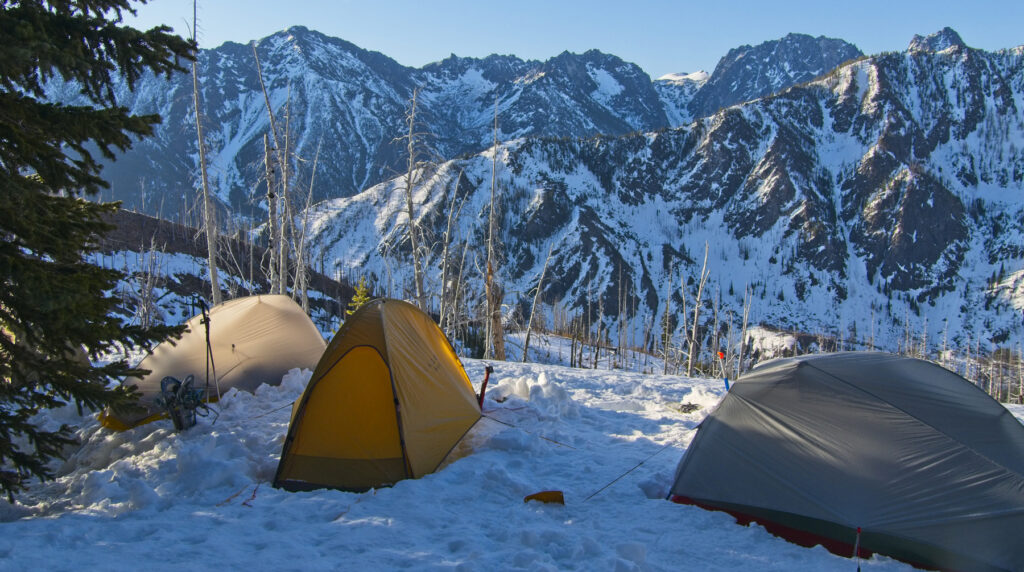
Gear
- Why don’t hikers share gear to reduce weight? Wouldn’t carrying one stove be better than twelve hikers carrying twelve stoves? Why not share tents, cooking gear, etc., like some mountain climbing expeditions? Sharing is fine, but everyone is required to be self-sufficient. Gear redundancy increases safety. Stoves are essential for restocking water and in emergencies, but stoves can fail. Having multiple stoves helps ensure that there is always a backup if someone’s stove fails. On one trip, three stoves failed. Also, if someone gets separated from the group, they are self-sufficient and not carrying all the group’s food, tents, cooking gear, or first aid.
- Do the trips involve technical climbing gear? This is not a mountaineering meetup. The main goal is to enjoy beautiful views and winter landscapes in comfort. Most routes have very little or no class 3 sections. The destination may be a specific mountain, but that may not include the summit. Peak bagging is not the aim of the meetup. This meetup is for backpacking. However, it is up to the group to decide if they want to bring gear to summit a peak.
- Will anyone inspect my pack to make sure I have everything I require to be safe and comfortable? You can ask another hiker to do that, but it is not part of the routine. You can use the free gear checklists on this website and do your own visual gear inspection before meeting with the group. Different trips have different gear requirements and it is common for hikers to ask questions and discuss gear with each other in the comment section of the trip being scheduled. Always do a visual gear inspection with a checklist before arriving. Also check snowshoes for wear and tear.
- What are the most noticeable differences between three-season hikers and winter backpackers? Experienced winter backpackers carry more wind and UV protection, may leave unlaced the bottom eyelets on their boots, pack their sleeping bags and a dedicated night-time base layer in dry sacks, don’t use pack bladders, store their hiking clothes in their sleeping bags at night, use liquid fuel stoves in cold conditions, always keep a folded solid pad under their feet and butt around camp, and have large baskets on their trekking poles.
- What are a few of the most common mistakes made by experienced 3-season hikers when winter backpacking? Common mistakes include starting the hike wearing too many layers, wearing boots that are too tight, sleeping in sweaty clothes, relying on pack bladders, using canister stoves in temps below 10 degrees, standing on snow around camp while cooking and packing up, not bringing a solid-core pad, packing insufficient wind and UV protection, having no baskets on their trekking poles or baskets that are too small, and using flat-terrain snowshoes in the mountains. Hikers can often power through their mistakes, but they would be more comfortable if they didn’t have to.
- Do I need bear spray? Very unlikely in the Cascade Mountains. Outside of the National Parks, you are unlikely to see bears. Statistically, you are far more likely to be accidentally shot by a hunter, especially in the fall. So bright clothing is more important than bear spray.
- Can I bring a gun? Please don’t. If you are concerned about self-protection, bring bear spray.
- Do I need a bear canister? In some places, it is required. A bear-proof container is required in the Baker-Snoqualmie National Forest which covers the majority of our destinations. Where it is not required you still need some way to protect your food from rodents and foxes, especially if you are located near an established campsite.
- Can I hang a food bag on a tree limb instead of caring a heavy bear canister? It is extremely rare to find suitable trees for hanging a bear sack at high elevations or in the wintertime. If rodents are the main concern and you want to avoid the weight of a bear canister, consider an inexpensive metal lunch box. In most cases, you will need an Ursack or Canister.
- Are glacier glasses or goggles required? March to July, when the days are clearer and brighter and the ground is still covered in snow, the UV conditions can be extreme, even when there are clouds, leading to extreme sunburn and snow blindness. You also need to be able to cover all flesh to prevent painful burns, including your lips and the bottom of your nose because the sun reflects up from the snow. Category-4 glacier glasses or ski goggles are necessary protection (cost range $40–400) depending on the route and destination. Goggles are important for wind protection during all the winter months, so check the wind forecast before packing.
- Can I use a pack bladder in winter conditions? No. Experienced 3-season hikers commonly think they can prevent it from freezing, but on many trips it is impossible. It is best not to take the risk. Carry Nalgene bottles that can safely hold boiling water and bring a metal thermos, especially on trips below 20º F.
- Why don’t you build campfires in winter? We are camping in the Cascade Mountains, usually at high elevations where organic material is scarce and fires are prohibited. Building fires in the snow is impractical, inefficient, and unnecessary. The attempt to gather firewood usually results in people getting themselves and their gear wet, which is a hazard. The sound and light of a campfire tend to isolate you from the stars and sounds of the wilderness. If your winter gear doesn’t allow you to conserve and maintain your heat and stay comfortable without a fire, you don’t have the correct gear or you are not using it correctly.
- How do you stay warm around camp? Your gear should keep you warm and you can always make a hot-water bottle and put it in your jacket or sleeping bag or next to your feet if you want to. Always keep a folded solid-core pad under your feet and butt. Follow “don’t-loose-your-heat” practices.
- Have you ever built a campfire on one of your winter trips? No. Fires are not allowed.
- Why do you use wag-bags and carry out your poop? Pooping in the snow will pollute the area after the snow melts. There are so many people using the wilderness that many areas have carry-out policies. It is a good practice for everyone to follow.
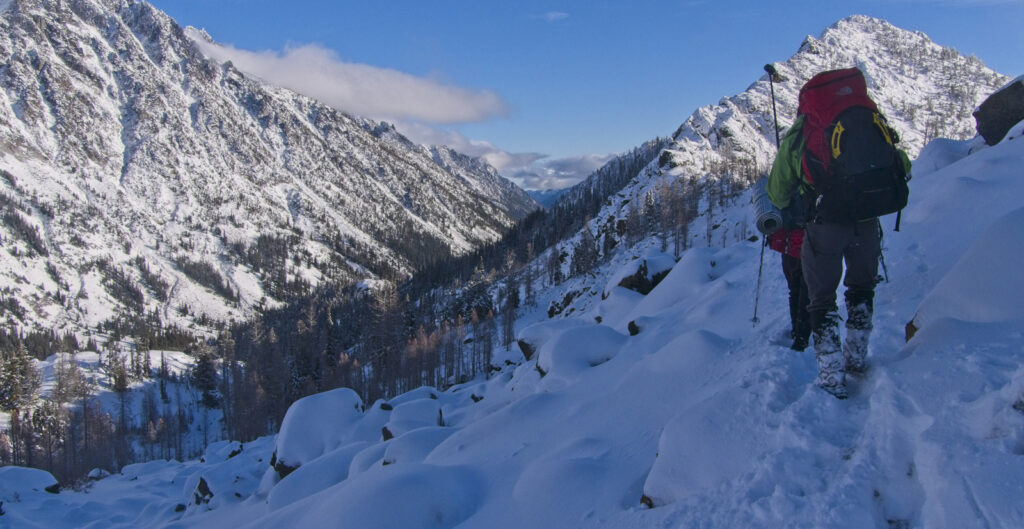
Weather
- What is the coldest temperature you have experienced on a trip? The coldest recorded thermometer temperature is 6º F on several trips. Temperatures on most trips are in the 20–35º F range. There were likely slightly colder trips, but no thermometer was there to determine the exact temperatures.
- Are you cold and do you have to be able to endure cold more than the average person? No. You should not be cold or have to endure being cold. We rely on appropriate gear and techniques to maintain warmth at all times.
- What are the highest winds you have experienced in winter? Probably 40–50 mph winds. We have had three tents damaged by high winds in the 20–40 mph range. All were 3-season ultra-light 2-person tents. Ultra-light 3-season 1-person tents held up fine on the same trips.
- How do you keep your feet and hands warm? You must keep your core warm by layering your clothes correctly and making sure boots and gloves are not too tight. Most every beginner has cold feet because their boots are too tight. More information about cold-weather techniques is available on the winter backpacking website (See https://winterbackpacking.com/what-are-the-best-gloves-for-winter-backpacking/ and https://winterbackpacking.com/how-to-keep-your-feet-warm/)
- Why is wind protection so important in winter and if so, why do you often camp on exposed ridges? High winds are more frequent and stronger in winter creating colder wind chill conditions. Being prepared for wind means having the ability to cover all exposed flesh (hardshell jacket, rain pants, mittens, balaclava, and goggles) and ideally a 4-season tent. If you are correctly prepared, you can enjoy the best views on an exposed ridge. If the forecast indicates winds will be so high that camp must be situated in a sheltered area we will likely reschedule. However, high winds are unpredictable and it is best to be prepared.
Please let us know what you think in the comment section below.
